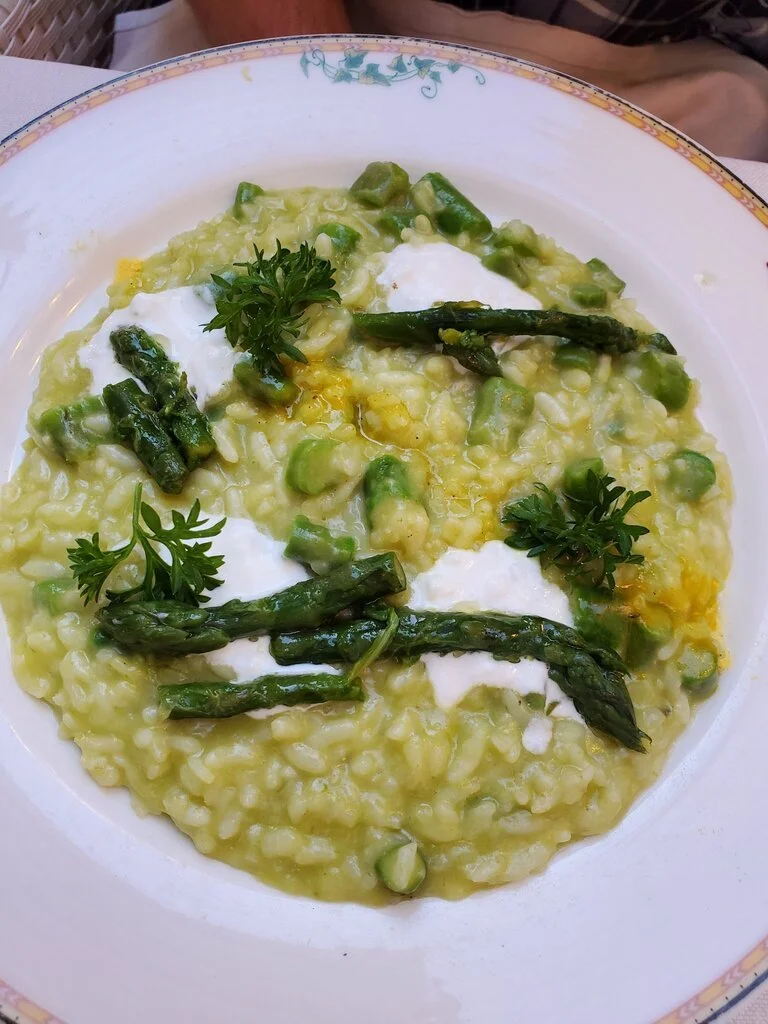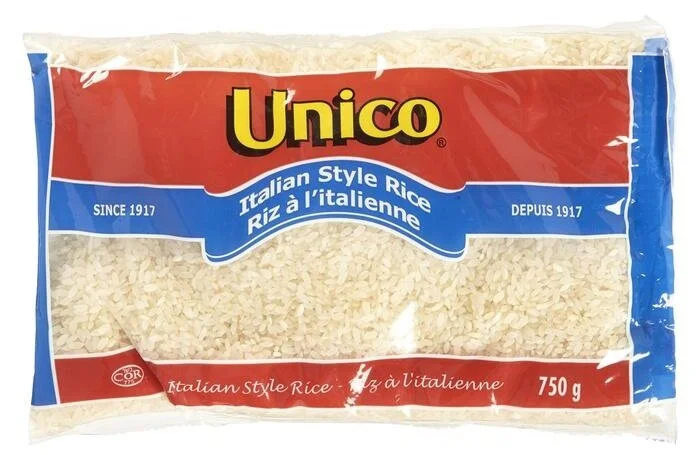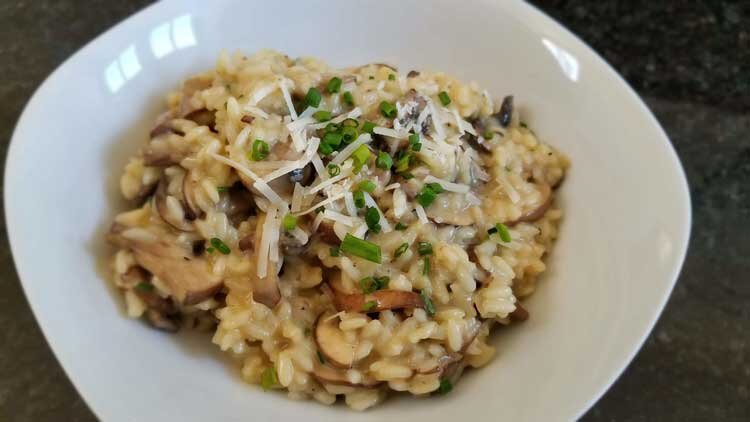How to Make Risotto: Everything You Need to Know
We started Mediocre Chef because we wanted to try new cooking techniques and recipes. We’ve learned how to make pasta from scratch and how to make homemade pizza, so naturally another Italian food we wanted to try was risotto! We had the same perception of risotto as we did about souffles (which we also wrote about) — it’s easy to fuck up and takes a long time. While those things are true, media has over-exaggerated these qualities and makes it seem like they are things that only master chefs can make. We’re here to tell you that mediocre chefs can make risotto too!
What is Risotto?
Risotto is an Italian dish consisting of rice that’s been cooked in broth until it’s creamy. Classic risotto also typically includes some white wine, onion, and Parmesan cheese. That’s it! You can kick it up a notch with other ingredients such as mushrooms or a protein of your choice.
A very fancy risotto that Brittany ate while in Italy. Simply divine!
What Kind of Rice Do I Need For Risotto?
Traditionally you’re going to want to use with arborio or carnaroli rice. We used generic “Italian Style Rice” from the grocery store and that seemed to work out well. Really, any medium or short grain rice with a high starch content will be fine. These types of rice like to absorb liquid and the starch will help to create that super creamy sauce.
Fancy rice for poor people.
Mistakes to Avoid When Making Risotto
Make perfect risotto every time — don’t do these things:
Using the wrong kind of rice: don’t use jasmine, basmati, or whatever kind of rice you have laying around. We recommend sticking with arborio or carnaroli — or if you’re like us, “Italian Style Rice” because your grocery store somehow didn’t carry either of those.
Note: These are affiliate links that help us earn a small commission from your purchase. Each purchase supports the blog so we can continue to make content! If you use these links, we really appreciate it! Get dat rice.
Using cold stock: this will mess up the cooking process, as you’re constantly trying to reheat it as you cook your rice. Nope. Don’t do this.
Rinsing your rice: this gets rid of the starch, which risotto needs for that creamy risotto texture.
Over stirring: this can ruin the texture of your risotto. Stir every 30 seconds or so. You don’t have to stir constantly! (Phew.)
Cooking your veggies and rice together: think about how long your rice needs to be cooked and stirred for. Do you really want your vegetables in there? The correct answer is no. Asparagus, peas, mushrooms, or whatever you decide to put into your risotto, will become too soft if you cook them at the same time.
Being impatient: don’t add all of your liquid (usually stock) to your risotto at once.
Overcooking: don’t overcook your rice! It should be al dente and have a bit of a bite to it. You don’t want it to be mushy. That’s gross.
Do I Need to Use Wine?
Apparently not. Wine really only adds a touch of flavour and acidity to help balance the recipe. Swap the white wine for a touch of white wine vinegar or white balsamic vinegar that’s been diluted by stock as per our boi Adam Ragusea. But really, unless there’s some sort of reason that you absolutely cannot have wine, just add the wine. Then you get to say that you’re cooking with wine, and that’s an immediate +2 buff to your reputation.
Some for the risotto, some for you.
How Do I Cook Risotto?
You can do it one of two ways:
Over the stove in a pan
In an Instant Pot/pressure cooker
While the first way is more traditional, the second way also works well! We made risotto the traditional way versus the Instant Pot way to see how it would turn out.
Traditional: Mushroom Risotto
The traditional method of cooking risotto involves a lot of stirring and paying attention. For this experiment we decided to do a mushroom risotto, so we cooked the mushrooms in our pan first, and set them aside to add them back into our risotto at the end so they wouldn’t be all overcooked and mushy.
Next you’ll want to sweat your aromatics (typically a shallot or onion) before adding your rice and toasting it. After deglazing with white wine, you’ll then slowly (½ cup at a time) add in enough stock for the rice to cook in. Then stir and wait and stir and wait and stir and wait. Your risotto is done when it’s creamy (but not too thick) and the rice is cooked al dente.
This method is a bit of a pain in the ass, but isn’t as bad as it’s been made out to be. When everyone says that you have to constantly stir the risotto, it doesn’t mean that you need to be moving it around every second of the cooking process. It means that you have to pay attention to the cooking and not go off and watch YouTube videos every 5 minutes. Stir it enough so that nothing burns — approximately every 30 seconds or so.
We recommend having a little extra stock on hand just in case you need it. And don’t forget to add some parmesan at the end!
The result of all of your hard work? A delicious, creamy risotto that you made, all by yourself!
Instant Pot: Risotto With Asparagus & Peas
For our experiment, we loosely followed this Instant Pot Risotto recipe while at the same time referencing a few others to see if they changed their technique.
Instant Pots are the lazy way of cooking risotto. How does that saying go? Work smarter, not harder.
Who wants to stand in front of a pot and carefully stir, add more stock, stir, add more stock, and repeat? Pressure cookers offer a shortcut that makes risotto more family-friendly. (Just don’t tell your Italian friends you did this, they might disown you.)
Most recipes will tell you to set your pressure cooker to sauté mode and sauté shallots/onions before adding your rice to toast for a minute. Once that’s done, all you have to do is add your rice, wine, and broth, close the lid, and let it come to pressure. After it’s come to pressure it just takes 6 minutes to cook, and then you can do a quick release. From here you can add more stock if it’s too dry, then add parmesan, salt/pepper to taste, and any veggies you want.
We added asparagus and peas to our risotto, letting the peas cook from the residual heat from the rice. If you want to make a mushroom risotto with an Instant Pot, we’ve seen a few recipes call to sauté at the start and pressure cook them along with the rice… we have our doubts about this (soggy mushrooms, anyone?), but maybe it would work.
Is pressure cooking risotto lazy? Or smart?
Think you have what it takes to master risotto? Just imagine Gordon Ramsay screaming behind you as you stir your risotto, trying to get it just right. You can do it! Maybe you’ll even get a sweet compliment from this guy:
If it’s your first time making risotto, try this risotto recipe from Bon Apétit — it’s super simple and is a great base that you can customize.
Have a risotto success story or horror story? Share it in the comments below!






